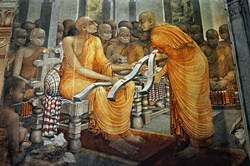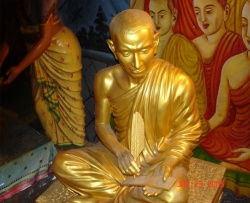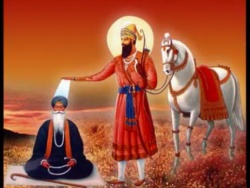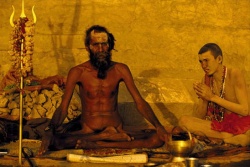Difference between revisions of "Buddhaghosa by Theosophy Trust"
m (Text replacement - "fulfilment" to "fulfilment") |
|||
| Line 1: | Line 1: | ||
[[File:9 Buddhaghosa.jpg|thumb|250px|]] | [[File:9 Buddhaghosa.jpg|thumb|250px|]] | ||
| + | |||
| + | |||
| + | |||
| + | |||
<poem> | <poem> | ||
| Line 51: | Line 55: | ||
In addition to [[virtue]] as a positive force generated through practice and {{Wiki|restraint}}, it [[forms]] the basis of [[dhutanga]], [[ascetic]] practice, which purifies motives and the [[powers]] of [[character]]. The thirteen [[forms]] of withdrawal are not to be understood as ways of escaping from the temptations of [[worldly]] involvements. Although retiring from the teeming thoroughfares of daily [[life]] can reduce external {{Wiki|distractions}}, an {{Wiki|individual}} takes his [[world]] – the tropism of [[consciousness]] – wherever he goes. [[Dhutanga]] aims to simplify one's [[desires]] and redirect one's motives, producing a [[contentment]] of [[mind]] and blamelessness of [[deed]] which allows one to take [[delight]] in treading the [[path of purification]]. [[Sila]] and [[dhutanga]] together provide the [[ethical]] and [[psycho-physical]] foundations for [[meditation]]. For [[Buddhaghosa]], [[concentration]] and [[meditation]] can take {{Wiki|myriad}} [[forms]], but those which aim towards [[realization]] and [[nibbana]] are those which nurture [[cittass]]' [[ekaggata]], unification and [[one-pointedness of mind]]. In his careful survey of [[Pali]] texts, [[Buddhaghosa]] discerned forty [[subjects]] suitable to this kind of [[meditation]]. | In addition to [[virtue]] as a positive force generated through practice and {{Wiki|restraint}}, it [[forms]] the basis of [[dhutanga]], [[ascetic]] practice, which purifies motives and the [[powers]] of [[character]]. The thirteen [[forms]] of withdrawal are not to be understood as ways of escaping from the temptations of [[worldly]] involvements. Although retiring from the teeming thoroughfares of daily [[life]] can reduce external {{Wiki|distractions}}, an {{Wiki|individual}} takes his [[world]] – the tropism of [[consciousness]] – wherever he goes. [[Dhutanga]] aims to simplify one's [[desires]] and redirect one's motives, producing a [[contentment]] of [[mind]] and blamelessness of [[deed]] which allows one to take [[delight]] in treading the [[path of purification]]. [[Sila]] and [[dhutanga]] together provide the [[ethical]] and [[psycho-physical]] foundations for [[meditation]]. For [[Buddhaghosa]], [[concentration]] and [[meditation]] can take {{Wiki|myriad}} [[forms]], but those which aim towards [[realization]] and [[nibbana]] are those which nurture [[cittass]]' [[ekaggata]], unification and [[one-pointedness of mind]]. In his careful survey of [[Pali]] texts, [[Buddhaghosa]] discerned forty [[subjects]] suitable to this kind of [[meditation]]. | ||
| − | [[Ten kasinas]], totalities, can be used: [[earth]], [[water]], [[fire]] and [[air]], blue, [[yellow]], [[red]] and white, {{Wiki|light}} and local [[space]]. Ten kinds of [[foulness]] can also be helpful, including the bloated, the livid, the festering, the cut, the scattered and the bleeding. There are ten kinds of [[recollection]] – of [[Buddha]], [[Dhamma]] and [[Sangha]]; of [[virtue]], [[generosity]], the [[deities]] and [[death]]; of [[mindfulness]] in [[respect]] to the [[body]], [[mindfulness]] in [[respect]] to [[breathing]], and [[recollection]] of [[peace]]. One can also take as a [[subject]] for [[meditation]] one of the four [[brahma-viharas]], [[sublime abodes]] – [[metta]], [[karuna]], [[mudita]] and [[upekkha]], [[love]], [[compassion]], [[joy]] and [[equanimity]] – providing that one extends these to include all [[beings]]. [[Four immaterial states]] can be used for [[meditation]]: [[boundless space]], {{Wiki|limitless}} [[consciousness]], [[nothingness]] and the [[state]] of [[neither perception nor non-perception]]. Finally, one [[perception]], the repulsiveness of [[food]], and one analysis, that of the [[four elements]], can be employed. These forty [[subjects]] for [[meditation]] constitute a pharmacopoeia for diverse temperaments, in which an {{Wiki|individual}} can use what he needs to achieve the basic plane of [[concentration]] required to undertake the [[stages of meditation]]. Those stages are reached in two ways, access and [[absorption]], for an {{Wiki|individual}} may {{Wiki|touch}} a higher [[degree]] of unified [[consciousness]] long before being able to maintain continuity in it. | + | [[Ten kasinas]], totalities, can be used: [[earth]], [[water]], [[fire]] and [[air]], blue, [[yellow]], [[red]] and white, {{Wiki|light}} and local [[space]]. Ten kinds of [[foulness]] can also be helpful, [[including]] the bloated, the livid, the festering, the cut, the scattered and the bleeding. There are ten kinds of [[recollection]] – of [[Buddha]], [[Dhamma]] and [[Sangha]]; of [[virtue]], [[generosity]], the [[deities]] and [[death]]; of [[mindfulness]] in [[respect]] to the [[body]], [[mindfulness]] in [[respect]] to [[breathing]], and [[recollection]] of [[peace]]. One can also take as a [[subject]] for [[meditation]] one of the four [[brahma-viharas]], [[sublime abodes]] – [[metta]], [[karuna]], [[mudita]] and [[upekkha]], [[love]], [[compassion]], [[joy]] and [[equanimity]] – providing that one extends these to include all [[beings]]. [[Four immaterial states]] can be used for [[meditation]]: [[boundless space]], {{Wiki|limitless}} [[consciousness]], [[nothingness]] and the [[state]] of [[neither perception nor non-perception]]. Finally, one [[perception]], the repulsiveness of [[food]], and one analysis, that of the [[four elements]], can be employed. These forty [[subjects]] for [[meditation]] constitute a pharmacopoeia for diverse temperaments, in which an {{Wiki|individual}} can use what he needs to achieve the basic plane of [[concentration]] required to undertake the [[stages of meditation]]. Those stages are reached in two ways, access and [[absorption]], for an {{Wiki|individual}} may {{Wiki|touch}} a higher [[degree]] of unified [[consciousness]] long before being able to maintain continuity in it. |
| − | When the [[mind]] is fully [[concentrated]] and free from {{Wiki|distractions}}, it is capable of entering the first [[stages of meditation]], known as the [[rupa jhanas]], or [[meditative]] states cognizant of [[form]]. In the initial [[rupa jhana]] one [[experiences]] [[vitakka]] and [[vicara]], [[samadhi]], [[sukha]] and [[piti]] – {{Wiki|reasoning}}, [[investigation]], inner [[seclusion]], [[pleasure]] and [[joy]]. Here the [[mind]] is active in every [[respect]], though focussed upon a single {{Wiki|ideal}} [[subject of meditation]]. Passage to the second [[rupa jhana]] occurs when both {{Wiki|reasoning}} and [[investigation]] are stripped away and one [[experiences]] the [[pleasure]] and [[joy]] of inner [[seclusion]]. As one ceases to be [[bound]] by the cruder [[forms]] of [[pleasure]] and [[pain]], one reaches the third [[rupa jhana]], characterized by [[joy]] and inner [[seclusion]]. When the [[root]] {{Wiki|polarity}} that gives rise to the pairs of opposites (including [[pleasure]] and [[pain]]) is removed, one dwells in the fourth [[rupa jhana]], inner [[seclusion]] and [[equanimity]]. Once this [[highest]] of the states which admit of [[form]] has been [[attained]], one is prepared to look deeply into the [[brahma-viharas]], the [[sublime abodes]], beginning with [[metta]]. | + | When the [[mind]] is fully [[concentrated]] and free from {{Wiki|distractions}}, it is capable of entering the first [[stages of meditation]], known as the [[rupa jhanas]], or [[meditative]] states cognizant of [[form]]. In the initial [[rupa jhana]] one [[experiences]] [[vitakka]] and [[vicara]], [[samadhi]], [[sukha]] and [[piti]] – {{Wiki|reasoning}}, [[investigation]], inner [[seclusion]], [[pleasure]] and [[joy]]. Here the [[mind]] is active in every [[respect]], though focussed upon a single {{Wiki|ideal}} [[subject of meditation]]. Passage to the second [[rupa jhana]] occurs when both {{Wiki|reasoning}} and [[investigation]] are stripped away and one [[experiences]] the [[pleasure]] and [[joy]] of inner [[seclusion]]. As one ceases to be [[bound]] by the cruder [[forms]] of [[pleasure]] and [[pain]], one reaches the third [[rupa jhana]], characterized by [[joy]] and inner [[seclusion]]. When the [[root]] {{Wiki|polarity}} that gives rise to the pairs of opposites ([[including]] [[pleasure]] and [[pain]]) is removed, one dwells in [[the fourth]] [[rupa jhana]], inner [[seclusion]] and [[equanimity]]. Once this [[highest]] of the states which admit of [[form]] has been [[attained]], one is prepared to look deeply into the [[brahma-viharas]], the [[sublime abodes]], beginning with [[metta]]. |
[[File:0hh.jpg|thumb|250px|]] | [[File:0hh.jpg|thumb|250px|]] | ||
He should first pervade himself with [[love]]. He can recollect such gifts, kindly words, and so on, as inspire [[love]] and endearment, and such [[virtue]] and {{Wiki|learning}} as inspire [[respect]] and reverence met with in a [[teacher]] or [[preceptor]], developing [[love]] towards him in the way beginning, 'May this good man be [[happy]] and free from [[suffering]].' With such a [[person]], of course, he attains [[absorption]]. | He should first pervade himself with [[love]]. He can recollect such gifts, kindly words, and so on, as inspire [[love]] and endearment, and such [[virtue]] and {{Wiki|learning}} as inspire [[respect]] and reverence met with in a [[teacher]] or [[preceptor]], developing [[love]] towards him in the way beginning, 'May this good man be [[happy]] and free from [[suffering]].' With such a [[person]], of course, he attains [[absorption]]. | ||
| Line 67: | Line 71: | ||
Each {{Wiki|distinct}} plane of [[consciousness]] is correlated with a level of being or {{Wiki|matter}}, and just as there are {{Wiki|immaterial}} and [[transcendental]] levels of being, so there are [[transcendent]] [[states of consciousness]]. From the terrace of the [[highest]] [[rupa]] [[Jhana]], the man of [[meditation]] may gain access to the four [[arupa]] or [[formless]] [[jhanas]]. By ignoring the material [[realms]] and dwelling upon the [[infinitude]] of [[space]], the [[yogin]] achieves [[akasanancayatana]], the [[formless realm]] of [[infinite space]], [[space]] without limits, qualities or [[objects]] of any kind. [[Meditation]] upon [[infinite space]] leads [[consciousness]] to realize its [[own]] [[infinitude]] (for it can entertain [[infinite space]] and not just some abstract {{Wiki|conception}} of it as an [[object of meditation]]), and the [[realm]] of [[vinnanancayatana]], [[infinite consciousness]], is [[attained]]. This [[realization]] leads naturally to the {{Wiki|recognition}} that nothing is {{Wiki|present}} to the [[awakened consciousness]], and the third [[formless realm]], that of [[akincannayatana]], or [[nothingness]], is reached. The [[meditator]] can now step to the limit of [[mundane]] [[existence]] with the [[realization]] of sanna-n'asannayatana, [[neither perception nor non-perception]]. The fourfold stages of both the [[rupa]] and [[arupa jhanas]] unfold naturally to the persistent [[practitioner]] of [[meditation]]. [[Tradition]] holds that [[Buddha]] was [[taught]] how to attain the last two degrees by two of his [[teachers]], [[Alara Kalama]] and [[Uddaka Ramaputta]]. For [[Buddha]], however, discovering the outermost limits of terrestrial [[consciousness]] was not enough, just as it was not the end of [[Buddhaghosa's]] commentary. | Each {{Wiki|distinct}} plane of [[consciousness]] is correlated with a level of being or {{Wiki|matter}}, and just as there are {{Wiki|immaterial}} and [[transcendental]] levels of being, so there are [[transcendent]] [[states of consciousness]]. From the terrace of the [[highest]] [[rupa]] [[Jhana]], the man of [[meditation]] may gain access to the four [[arupa]] or [[formless]] [[jhanas]]. By ignoring the material [[realms]] and dwelling upon the [[infinitude]] of [[space]], the [[yogin]] achieves [[akasanancayatana]], the [[formless realm]] of [[infinite space]], [[space]] without limits, qualities or [[objects]] of any kind. [[Meditation]] upon [[infinite space]] leads [[consciousness]] to realize its [[own]] [[infinitude]] (for it can entertain [[infinite space]] and not just some abstract {{Wiki|conception}} of it as an [[object of meditation]]), and the [[realm]] of [[vinnanancayatana]], [[infinite consciousness]], is [[attained]]. This [[realization]] leads naturally to the {{Wiki|recognition}} that nothing is {{Wiki|present}} to the [[awakened consciousness]], and the third [[formless realm]], that of [[akincannayatana]], or [[nothingness]], is reached. The [[meditator]] can now step to the limit of [[mundane]] [[existence]] with the [[realization]] of sanna-n'asannayatana, [[neither perception nor non-perception]]. The fourfold stages of both the [[rupa]] and [[arupa jhanas]] unfold naturally to the persistent [[practitioner]] of [[meditation]]. [[Tradition]] holds that [[Buddha]] was [[taught]] how to attain the last two degrees by two of his [[teachers]], [[Alara Kalama]] and [[Uddaka Ramaputta]]. For [[Buddha]], however, discovering the outermost limits of terrestrial [[consciousness]] was not enough, just as it was not the end of [[Buddhaghosa's]] commentary. | ||
[[File:33-Guru.jpg|thumb|250px|]] | [[File:33-Guru.jpg|thumb|250px|]] | ||
| − | The [[cultivation]] of [[meditation]] opens the way for the unfoldment of {{Wiki|supernormal}} capacities which nonetheless belong to the [[highest]] [[development]] of [[mundane consciousness]]. These [[abhinnas]] or higher [[forms]] of [[knowledge]] begin with the [[iddhis]] or [[supernormal powers]]. An {{Wiki|individual}} may learn to project numerous non-physical doubles of his [[body]] and thus appear simultaneously in more than one place. This mind-formed [[body]] can pass through walls, levitate, walk on [[water]] and perform marvellous feats. Though the [[manomaya]] [[form]] is not the [[physical body]], it marks a {{Wiki|perfect}} control of the constituents of the [[body]], [[elements]] of which can be used for the [[benefit]] of the [[world]] by [[Bodhisattvas]]. The second [[abhinna]] is [[dibba-sota]] or [[divine ear]], which is the [[perfection]] of clairaudience. The third, parassa cetopariya-nana or [[knowledge]] of other [[minds]], includes {{Wiki|telepathy}} in all its [[forms]], including the instantaneous [[understanding]] of each [[human]] [[heart]]. Pubbe-nivas anu-sati is the detailed and deliberate [[remembrance]] of former [[births]], a capacity which can safely be used only by those who have [[attained]] a high [[degree]] of [[self-knowledge]] and [[detachment]]. The fifth [[abhinna]], [[dibba-cakkhu]] or [[divine eye]], is more than {{Wiki|clairvoyance}}, for it allows its possessor to {{Wiki|witness}} the continuity of [[individual consciousness]] through the destruction and [[rebirth]] of different [[forms]]. The sixth [[abhinna]] is not [[mundane]], but [[transcendental]], because it involves the destruction of the [[asavas]], [[cravings]] for [[sensuous]] [[pleasure]], for [[embodied]] [[existence]] and [[ignorance]] – the 'three gates of [[hell]]'. | + | The [[cultivation]] of [[meditation]] opens the way for the unfoldment of {{Wiki|supernormal}} capacities which nonetheless belong to the [[highest]] [[development]] of [[mundane consciousness]]. These [[abhinnas]] or higher [[forms]] of [[knowledge]] begin with the [[iddhis]] or [[supernormal powers]]. An {{Wiki|individual}} may learn to project numerous [[non-physical]] doubles of his [[body]] and thus appear simultaneously in more than one place. This mind-formed [[body]] can pass through walls, levitate, walk on [[water]] and perform marvellous feats. Though the [[manomaya]] [[form]] is not the [[physical body]], it marks a {{Wiki|perfect}} control of the constituents of the [[body]], [[elements]] of which can be used for the [[benefit]] of the [[world]] by [[Bodhisattvas]]. The second [[abhinna]] is [[dibba-sota]] or [[divine ear]], which is the [[perfection]] of [[clairaudience]]. The third, parassa cetopariya-nana or [[knowledge]] of other [[minds]], includes {{Wiki|telepathy}} in all its [[forms]], [[including]] the instantaneous [[understanding]] of each [[human]] [[heart]]. Pubbe-nivas anu-sati is the detailed and deliberate [[remembrance]] of former [[births]], a capacity which can safely be used only by those who have [[attained]] a high [[degree]] of [[self-knowledge]] and [[detachment]]. The fifth [[abhinna]], [[dibba-cakkhu]] or [[divine eye]], is more than {{Wiki|clairvoyance}}, for it allows its possessor to {{Wiki|witness}} the continuity of [[individual consciousness]] through the destruction and [[rebirth]] of different [[forms]]. The sixth [[abhinna]] is not [[mundane]], but [[transcendental]], because it involves the destruction of the [[asavas]], [[cravings]] for [[sensuous]] [[pleasure]], for [[embodied]] [[existence]] and [[ignorance]] – the '[[three gates]] of [[hell]]'. |
Some aspirants attain the [[transcendental]] [[path]], [[lokuttara magga]], by passing through the various [[jhanas]] and destroying the [[asavas]]. Unfortunately, many get caught in one superconscious [[state]] or another and fail to gain the [[insight]] that emancipates one from involuntary [[incarnation]] in the ocean of [[samsara]]. Others follow the safer way of [[Buddha]], using the [[full concentration]] achieved to [[contemplate]] [[dukkha]], [[anicca]] or [[anatta]], the [[painful]], the transitory or the [[egoless]]. If the fundamental [[condition]] of differentiated [[existence]] is [[suffering]], then [[meditation]] upon this [[condition]] will reveal the [[aimlessness]] of the [[world]], that is, its incapacity for exhibiting [[eternal truths]]. If everything in the [[universe]] is [[impermanent]], [[meditation]] upon transitoriness will show that the [[world]] is [[signless]], unable to sustain the meaning of [[reality]] in its [[appearances]]. And if everything in the [[world]] is without [[essential nature]], [[meditation]] upon [[egolessness]] will demonstrate that [[appearances]] cannot [[delineate]] [[reality]]. If any one of these three lines of [[meditation]] is pursued to its end, [[realization]] of [[transcendental wisdom]] is inevitable. This is the way of direct [[insight]]. Thus the process which had its source in [[sila]], [[virtue]], and flowed together into the mighty {{Wiki|stream}} of [[samadhi]], [[meditation]], eventually reaches the [[boundless]] ocean of [[panna]], [[wisdom]]. | Some aspirants attain the [[transcendental]] [[path]], [[lokuttara magga]], by passing through the various [[jhanas]] and destroying the [[asavas]]. Unfortunately, many get caught in one superconscious [[state]] or another and fail to gain the [[insight]] that emancipates one from involuntary [[incarnation]] in the ocean of [[samsara]]. Others follow the safer way of [[Buddha]], using the [[full concentration]] achieved to [[contemplate]] [[dukkha]], [[anicca]] or [[anatta]], the [[painful]], the transitory or the [[egoless]]. If the fundamental [[condition]] of differentiated [[existence]] is [[suffering]], then [[meditation]] upon this [[condition]] will reveal the [[aimlessness]] of the [[world]], that is, its incapacity for exhibiting [[eternal truths]]. If everything in the [[universe]] is [[impermanent]], [[meditation]] upon transitoriness will show that the [[world]] is [[signless]], unable to sustain the meaning of [[reality]] in its [[appearances]]. And if everything in the [[world]] is without [[essential nature]], [[meditation]] upon [[egolessness]] will demonstrate that [[appearances]] cannot [[delineate]] [[reality]]. If any one of these three lines of [[meditation]] is pursued to its end, [[realization]] of [[transcendental wisdom]] is inevitable. This is the way of direct [[insight]]. Thus the process which had its source in [[sila]], [[virtue]], and flowed together into the mighty {{Wiki|stream}} of [[samadhi]], [[meditation]], eventually reaches the [[boundless]] ocean of [[panna]], [[wisdom]]. | ||
Latest revision as of 09:50, 15 March 2024
The Buddha said: "When the wise man, grounded
well in virtue,
Cultivates consciousness and understanding
Then this bhikkhu, ardent and sagacious,
Succeeds in unravelling the tangle."
My task is to set out the true meaning,
Divided into virtue and the rest,
Of this verse composed by the Great Sage.
For there are seekers of the Victor's way,
Who have gone from home to homelessness,
And who, though desiring purity,
Know not the sure straight path
Of virtue, consciousness and understanding.
Difficult to find, leading to purity,
Who strive and have yet to gain it,
To them I teach the comforting path
Of purification, pristine in discourse,
Relying on the teaching of those who dwell
In the Great Monastery, Anuradhapura.
Let those who desire the pure way
Listen intently to these words.
Visuddhimagga BUDDHAGHOSA
The spectacular rise of the Great Vehicle after the dissemination of the MahayanaSutras overshadowed the evolution of other schools. Buddhists who focussed on non-Mahayana texts remained active and produced an enormous literature in Pali, the literary and textual language of non-Mahayana Buddhist thought. They did not, however, produce a teacher of comparable stature to Nagarjuna, Aryadeva or Asanga. Consequently, their numbers waned and many texts were lost in India before the Mahayana crossed the Himalayas into Tibet. Yet one man stood out, in part because he chose to go to Sri Lanka and preserve the work begun there by Mahendra, the son of King Ashoka. The response to his efforts invigorated the Theravada, which is the only non-Mahayana school which has survived to the present day and which spread throughout Southeast Asia. Bhadantacariya Buddhaghosa gathered all the sources he could find and composed definitive expositions of Theravadin doctrine and practice, deliberately subordinating his considerable originality to faithfulness to his revered tradition.
Though a modern edition of Buddhaghosa's works fills thirty volumes, little is known of his life and activities. The first great impulse of Buddhist thought, initiated by Buddha and culminating in the formation of the Tripitaka, the Three Baskets of teachings, spread to Sri Lanka with the arrival of Mahendra and a cutting from the original Bodhi Tree under which Buddha achieved Enlightenment. There the sacred texts were preserved in Pali but elucidated in Sinhalese, though Buddhist thought drifted towards stagnation in the first centuries of the common era. The Great Monastery (Mahavihara), founded in Mahendra's time, flourished under royal patronage, but the Mahayana tendencies of the rival Abhayagiri Monastery produced a reaction that resulted in a stultifying concern for orthodoxy. Meanwhile, Indian Buddhists eventually embraced the Great Vehicle and left Sri Lanka virtually isolated, the preserver of texts and materials neglected by the rest of the Buddhist world. Buddhaghosa was born during this period of Theravadin decline around A.D. 400 in Ghosa near Bodh Gaya, according to a very late and perhaps imaginary legend. Amongst the sparse details that he gives about himself, he declared that he once lived in Kanchipuram and in Morandacetaka, which some historians identify with Mylapore near Madras.
According to the Mahavamsa, the chronicle of Sri Lanka, Buddhaghosa was born a Brahmin and became a devoted student of Patanjali's Yoga Sutras. Once in the course of reciting the Sutras aloud, he was overheard by a Buddhist monk named Revata, who proceeded to explain each passage fully. When Buddhaghosa asked after the source of the monk's wisdom, he pointed to the Enlightened One, and Buddhaghosa joined the Sangha. Because his speech – ghosa – was deep and resonant, carrying far like the word of Buddha, he received the name by which history knows him. After a serious study of the Tripitaka,he sought insightful commentaries on its treatises, but Revata told him that only Sri Lanka had kept them pure. Upon his teacher's suggestion, Buddhaghosa journeyed to Anuradhapura, the royal capital of Sri Lanka, and established himself in the Great Monastery within sight of the sapling of the Bodhi Tree. When he announced his intention to translate the Sinhalese commentaries into Pali for the benefit of his Indian co-disciples, the elders tested him by giving him two verses for a complete commentary. The result was the Visuddhimagga (The Path of Purification). No sooner had he completed it, however, than a group of deities hid the work, and he had to undertake the task again. These deities repeated the theft, but Buddhaghosa compiled a third commentary. When the elders came to view the finished treatise, the deities produced the first two versions, and when everyone saw that the three were identical in every respect, an elder said, "Surely this is the Bodhisattva Metteyya."
Buddhaghosa was entrusted with all the revered literature of the Great Monastery, and rather than simply translating it into Pali, he created a number of compendia which gathered all the relevant literature under a schematized list of subjects. He thus produced a kind of encyclopaedia of Sinhalese Buddhist thought. Since almost all the sources he used have been lost to history, his selfless effort saved for posterity the efflorescence of Ashoka's great missionary undertaking. His labours also inspired a renewal of Theravadin creativity both in Sri Lanka and in South India. This renaissance continued until it blossomed yet again in Burma, which helped Sri Lanka keep Buddha's message alive after it had disappeared from its original home. Though nothing is known about the length of Buddhaghosa's stay in Anuradhapura, history suggests that he eventually returned to India and probably took part in the resurgence of Pali Buddhist thought there. His last years and death are secrets of silent time.
The Visuddhimagga is perhaps Buddhaghosa's greatest work. Beginning with a description of sila, virtue, and its purpose, fruition and benefits, it passes on to an extensive discussion of samadhi, concentration or meditation, leading to vipassana, insight, and a full understanding of the Four Noble Truths. After a lengthy theoretical exposition of panna, understanding, practical applications are brought to bear on meditation experiences. Finally, advanced stages of realization leading to nibbana are delineated. For Buddhaghosa, the four stages of the spiritual Path are marked by distinct perfections. One who has "entered the stream" as well as one who has but one life remaining before Enlightenment is marked by perfection in sila. An individual who will not be subject to involuntary incarnations in the future exhibits perfection in samadhi, and one who has become an arahant and experienced the supreme culmination of realization is perfect in vipassana. Virtue involves the volition of one who follows the path of purification, for it requires both the fulfilment of duty and deliberate self-restraint. Virtue (sila) composes (silana) the individual through consistent self-coordination and through upholding edifying thoughts and intentions, and so virtue is like the head (siras) of the body, directing all its members, and it is cool (sitala), calming every impulse.
Who would dare to circumscribe
The benefits that virtue brings,
Without which clansmen
Find no footing in the Teaching?
No Ganges, no Yamuna,
No Sarabhu or Sarassati,
Nor flowing Aciravati
Nor noble Maul River,
Can wash away the stain of things
That breathe in this world.
Only sila's waters
Cleanse the stain in living things.
In addition to virtue as a positive force generated through practice and restraint, it forms the basis of dhutanga, ascetic practice, which purifies motives and the powers of character. The thirteen forms of withdrawal are not to be understood as ways of escaping from the temptations of worldly involvements. Although retiring from the teeming thoroughfares of daily life can reduce external distractions, an individual takes his world – the tropism of consciousness – wherever he goes. Dhutanga aims to simplify one's desires and redirect one's motives, producing a contentment of mind and blamelessness of deed which allows one to take delight in treading the path of purification. Sila and dhutanga together provide the ethical and psycho-physical foundations for meditation. For Buddhaghosa, concentration and meditation can take myriad forms, but those which aim towards realization and nibbana are those which nurture cittass' ekaggata, unification and one-pointedness of mind. In his careful survey of Pali texts, Buddhaghosa discerned forty subjects suitable to this kind of meditation.
Ten kasinas, totalities, can be used: earth, water, fire and air, blue, yellow, red and white, light and local space. Ten kinds of foulness can also be helpful, including the bloated, the livid, the festering, the cut, the scattered and the bleeding. There are ten kinds of recollection – of Buddha, Dhamma and Sangha; of virtue, generosity, the deities and death; of mindfulness in respect to the body, mindfulness in respect to breathing, and recollection of peace. One can also take as a subject for meditation one of the four brahma-viharas, sublime abodes – metta, karuna, mudita and upekkha, love, compassion, joy and equanimity – providing that one extends these to include all beings. Four immaterial states can be used for meditation: boundless space, limitless consciousness, nothingness and the state of neither perception nor non-perception. Finally, one perception, the repulsiveness of food, and one analysis, that of the four elements, can be employed. These forty subjects for meditation constitute a pharmacopoeia for diverse temperaments, in which an individual can use what he needs to achieve the basic plane of concentration required to undertake the stages of meditation. Those stages are reached in two ways, access and absorption, for an individual may touch a higher degree of unified consciousness long before being able to maintain continuity in it.
When the mind is fully concentrated and free from distractions, it is capable of entering the first stages of meditation, known as the rupa jhanas, or meditative states cognizant of form. In the initial rupa jhana one experiences vitakka and vicara, samadhi, sukha and piti – reasoning, investigation, inner seclusion, pleasure and joy. Here the mind is active in every respect, though focussed upon a single ideal subject of meditation. Passage to the second rupa jhana occurs when both reasoning and investigation are stripped away and one experiences the pleasure and joy of inner seclusion. As one ceases to be bound by the cruder forms of pleasure and pain, one reaches the third rupa jhana, characterized by joy and inner seclusion. When the root polarity that gives rise to the pairs of opposites (including pleasure and pain) is removed, one dwells in the fourth rupa jhana, inner seclusion and equanimity. Once this highest of the states which admit of form has been attained, one is prepared to look deeply into the brahma-viharas, the sublime abodes, beginning with metta.
He should first pervade himself with love. He can recollect such gifts, kindly words, and so on, as inspire love and endearment, and such virtue and learning as inspire respect and reverence met with in a teacher or preceptor, developing love towards him in the way beginning, 'May this good man be happy and free from suffering.' With such a person, of course, he attains absorption.
Karuna cannot be readily aroused by concentrating on those one likes, dislikes or is indifferent to.
First of all, on seeing a wretched man, unlucky, unfortunate, in every way a fit object for compassion, unsightly, reduced to utter misery. . .compassion should be felt for him in this way: This being has indeed been reduced to misery; if only he could be freed from this suffering! . . . Having aroused compassion in this way, compassion can be aroused for a person dear to one, indifferent to one, and hostile to one, respectively.
Contrary to the method for nurturing compassion, mudita or joy can be engendered on behalf of the good fortune of one closest to oneself, a boon companion. Then that joy can be extended to those who are emotionally and psychologically neutral in respect to oneself, and finally, towards those who are hostile. Upekka, or equanimity, is best aroused initially towards a neutral party, then extended to include those dear to one, those hostile to one, and, lastly, towards oneself. Insight is the product of realizing the four sublime abodes, but one must be careful not to succumb to the near enemy or come to fear the far enemy of each. The simulacrum of love is greed, since, like love, it appreciates virtues, and the far enemy is ill will, frighteningly alien to love. The near enemy of compassion is grief, for both witness human failure, and its opposite is cruelty. Joy rooted in the settled and comfortable life of the home is the near enemy of universal joy, and aversion or boredom is its distant foe. The 'bliss' of ignorance is the near enemy of equanimity, since both overlook faults, and it is opposed by greed and resentment.
These ways of abiding are best in being the right attitude towards beings. And just as Brahma-gods abide with pure and pristine minds, so the meditators who associate themselves with these brahma-viharas dwell on an equal footing with these deities.
Each distinct plane of consciousness is correlated with a level of being or matter, and just as there are immaterial and transcendental levels of being, so there are transcendent states of consciousness. From the terrace of the highest rupa Jhana, the man of meditation may gain access to the four arupa or formless jhanas. By ignoring the material realms and dwelling upon the infinitude of space, the yogin achieves akasanancayatana, the formless realm of infinite space, space without limits, qualities or objects of any kind. Meditation upon infinite space leads consciousness to realize its own infinitude (for it can entertain infinite space and not just some abstract conception of it as an object of meditation), and the realm of vinnanancayatana, infinite consciousness, is attained. This realization leads naturally to the recognition that nothing is present to the awakened consciousness, and the third formless realm, that of akincannayatana, or nothingness, is reached. The meditator can now step to the limit of mundane existence with the realization of sanna-n'asannayatana, neither perception nor non-perception. The fourfold stages of both the rupa and arupa jhanas unfold naturally to the persistent practitioner of meditation. Tradition holds that Buddha was taught how to attain the last two degrees by two of his teachers, Alara Kalama and Uddaka Ramaputta. For Buddha, however, discovering the outermost limits of terrestrial consciousness was not enough, just as it was not the end of Buddhaghosa's commentary.
The cultivation of meditation opens the way for the unfoldment of supernormal capacities which nonetheless belong to the highest development of mundane consciousness. These abhinnas or higher forms of knowledge begin with the iddhis or supernormal powers. An individual may learn to project numerous non-physical doubles of his body and thus appear simultaneously in more than one place. This mind-formed body can pass through walls, levitate, walk on water and perform marvellous feats. Though the manomaya form is not the physical body, it marks a perfect control of the constituents of the body, elements of which can be used for the benefit of the world by Bodhisattvas. The second abhinna is dibba-sota or divine ear, which is the perfection of clairaudience. The third, parassa cetopariya-nana or knowledge of other minds, includes telepathy in all its forms, including the instantaneous understanding of each human heart. Pubbe-nivas anu-sati is the detailed and deliberate remembrance of former births, a capacity which can safely be used only by those who have attained a high degree of self-knowledge and detachment. The fifth abhinna, dibba-cakkhu or divine eye, is more than clairvoyance, for it allows its possessor to witness the continuity of individual consciousness through the destruction and rebirth of different forms. The sixth abhinna is not mundane, but transcendental, because it involves the destruction of the asavas, cravings for sensuous pleasure, for embodied existence and ignorance – the 'three gates of hell'.
Some aspirants attain the transcendental path, lokuttara magga, by passing through the various jhanas and destroying the asavas. Unfortunately, many get caught in one superconscious state or another and fail to gain the insight that emancipates one from involuntary incarnation in the ocean of samsara. Others follow the safer way of Buddha, using the full concentration achieved to contemplate dukkha, anicca or anatta, the painful, the transitory or the egoless. If the fundamental condition of differentiated existence is suffering, then meditation upon this condition will reveal the aimlessness of the world, that is, its incapacity for exhibiting eternal truths. If everything in the universe is impermanent, meditation upon transitoriness will show that the world is signless, unable to sustain the meaning of reality in its appearances. And if everything in the world is without essential nature, meditation upon egolessness will demonstrate that appearances cannot delineate reality. If any one of these three lines of meditation is pursued to its end, realization of transcendental wisdom is inevitable. This is the way of direct insight. Thus the process which had its source in sila, virtue, and flowed together into the mighty stream of samadhi, meditation, eventually reaches the boundless ocean of panna, wisdom.
The power of concentration brought to the precise focus implicit in the art of meditation yields knowledge of samsara and realization of nibbana. The enlightened man, arahant, knows the world of relative truth as well as the indescribable truth of reality. He has fully developed panna, understanding.
With dreadful thump the thunderbolt
Annihilates the boulder.
The driven, fire-whipped wind
Annihilates the wood.
The radiant orb of solar flame
Annihilates the darkness.
And developed understanding, too,
Annihilates the tangled overgrowth
Of inveterate defilements,
The source of every woe.
Yet its blessing even in this life
A man himself may know.
Buddhaghosa collated Theravadin wisdom in ways which made it accessible and readily transmitted. Though meditation waned as a central practice in Sri Lanka and South Asia, his work was preserved and revered. In the twentieth century, however, monks have awakened to the lasting importance of his message, and once again concentration is becoming the beacon-light of the Theravadin path.
I will declare to thee that utmost lore,
Whole and particular, which, when thou knowest,
Leaveth no more to know here in this world.
SHRI KRISHNA
Source
Elton A. Hall
theosophytrust.org





